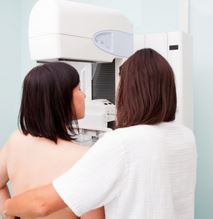
Going for your first mammogram can be a scary time however rest assured that this simple exam can be a lifesaving event. They are the first line in diagnosing breast cancer as well as any other abnormalities in the breast which is why it is so important to have one done yearly after you turn 40. It is also the less intrusive way of viewing the inner tissues of the breast area. Your doctor may recommend to begin mammography at a younger age depending upon your risk factors. Clinical breast exams begin in your twenties (20’s) and if a mass is felt at that time, a breast ultrasound (also known as a sonogram) may be recommended and a mammogram and/or MRI if needed.
What is a Mammogram?
Simply put the mammogram is an x-ray of the breasts. The x-ray takes place in a radiologist’s clinic or office and it may also be followed by a sonogram especially if you have “dense” breast tissue. This in combination with your Dr’s breast exam (or your own self-exam) will be able to alert the doctor of any abnormalities in the breast tissues. Detecting these abnormalities are crucial to detecting breast cancer in its early stages thus greatly improving the chances of beating and treating the cancer. Throughout a woman’s life the breasts change for many different reasons such as monthly during menstrual cycles, during pregnancy, during menopause and also from taking hormones. The shape of the breast can also be “irregular” due to the same reasons but are actually a normal occurrence so these should not be worrisome symptoms. Anything out of the norm is cause for concern. Mammograms should be done every year starting a age 40 or earlier if there is a history of breast cancer in the family.
Sounds Scary, How Do They Take The X-Rays?
The x-rays are taken by placing each breast (one at a time) in between an x-ray plate and a plastic plate that squeeze the breast as much as safely possible to get a better view of the inside of the breast. The plates are hooked up to an x-ray imaging machine which then snaps “pictures” to determine if there are any abnormalities that need further examination. The exam itself is simply and quick – average time is about 15-20 minutes but be prepared to experience discomfort. Thankfully it only lasts a few seconds! There are two types of mammograms and each one differs only in the amount of x-rays taken. The screening mammogram is done for women who have no symptoms of breast cancer and only 2 x-rays of each breast are taken. These images can show lumps or tumors that cannot be felt and can also show any microcalcifications in the area. The diagnostic mammogram is done after a sign of breast cancer was detected during the screening mammogram or if the woman has detected any abnormalities on her own during a self-exam or if her physician feels a mass. This type of mammogram involves several x-rays of the breast from different angles.
What Are the Signs of Breast Cancer?
There are no outward signs of breast cancer however there are things to look for such as nipple discharge, lumps around the breast, pain in the breast ( that is not associated with menstrual or hormonal changes) thickened skin on the breast or changes in size and shape of the breast(s). The inward signs are lumps, masses and calcifications. There are two types of calcifications: macro and microcalcifications. A calcification is a deposit of calcium in the breast tissues. The macro type is usually formed as a woman ages and is usually not a need for concern. The micro type consist of smaller deposits however these are found together with other dividing cells that are doing so in a very fast fashion. These should be examined more closely as they may be a sign of cancer.
I Had My Exam, Now What?
After your exam you should have the results within a few days. Keep in mind that even though mammograms are usually the best way of early detection, they are not perfect. There are times that you will test positive for abnormalities yet have none or test normal yet there are underlying issues present. There are also times when the mammogram and breast sonogram can be normal and the cancer can only be felt, which is why it is equally important to have a qualified provider examine you. Please know that these instances are rare but can happen as with any other medical exam. It is best to learn how to self examine you own breast. This in conjunction with your routine medical exam and the mammogram can be the best defensive tactic against cancer.
